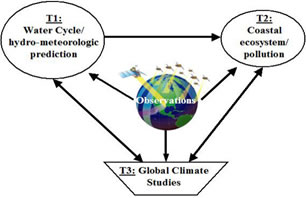References
Anagnostou, E.N., 2005 (in press): Assessment of satellite rain retrieval error propagation in the prediction of land surface hydrologic variables, Book Chapter in Measuring Precipitation from Space: EURAINSAT and the Future, (eds) V. Levizzani, P. Bauer and F.J. Turk. Kluwer Academic Publishers.
Hossain, F., and E.N. Anagnostou, 2005: Numerical Investigation of the Impact of Uncertainties in Satellite Rainfall and Land Surface Parameters on Simulation of Soil Moisture. Advances in Water Resources, Volume 28, Issue 12, December 2005, Pages 1336-1350.
Kim Y and Wang GL, 2005: Modeling seasonal vegetation variation and its validation against Moderate Resolution Imaging Spectroradiometer (MODIS) observations over North America, JGR - Atmospheres, 110, D04106, doi:10.1029/2004JD005436.
Mitchell, K.E., Lohmann, D., Houser, P. R., Wood, E. F., Schaake, J. C., Robock, A., Cosgrove, B., Sheffield, J., Duan, Q., Luo, L., Higgins, W. R., Pinker, R. T., Tarpley, J. D., Lettenmaier, D. P., Marshall, C. H., Entin, J. K., Pan, M., Shi, W., Koren, V., Meng, J., Ramsay, B. H. and Bailey, A. A., 2004: The Multi-institution North American Land Data Assimilation System (NLDAS): Utilization of multiple GCIP products and partners in a continental distributed hydrological modeling system. J. of Geoph. Res.-Atmospheres, 109:doi:10.1029/2003JD003823.
Morales, C., and E.N. Anagnostou, 2003: Extending the Capabilities of High-frequency Rainfall Estimation from Geostationary-Based Satellite Infrared via a Network of Long-Range Lightning Observations. Journal of Hydrometeorology, 4(2), 141-159.
Papadopoulos, A., T.G. Chronis and E. N. Anagnostou, 2005: Improving Convective Precipitation Forecasting Through Assimilation of Regional Lightning Measurements in a Mesoscale Model, Monthly Weather Review, Vol. 133, 1961–1977.
Tzortziou, M., Neale, P., Gallegos, C., Osburn, C., Herman, J., and Megonigal, P., 2005a: Sources and cycling of Chromophoric Dissolved Organic Material in the estuarine waters of the Rhode River sub-estuary and the Chesapeake Bay, ASLO Summer Meeting 2005, Santiago de Compostela, Spain, 19-24 June.
Tzortziou M., A. Subramaniam, J. Herman, C. Gallegos, and P. Neale, 2005b (submitted): Remote Sensing Reflectance and Inherent Optical Properties in the Chesapeake Bay waters, Estuarine Coastal and Shelf Science
Tzortziou M., J. Herman, C. Gallegos, P.Neale, A. Subramaniam, L. Harding, and Z. Ahmad, 2005c (submitted): Optical properties and radiative transfer in the Chesapeake Bay estuarine waters: An in-water optical closure experiment, Estuarine Coastal and Shelf Science
Wang DG, Wang GL, Anagnostou EN, 2005: Use of satellite-based precipitation observation in improving the parameterization of canopy hydrological processes in land surface models. Journal of Hydrometeorology, 6, 745-763.
Wang GL, and Eltahir EAB, 2000: Impact of rainfall sub-grid variability on modeling the biosphere-atmosphere system. Journal of Climate, 13, 2887-2899.
|



